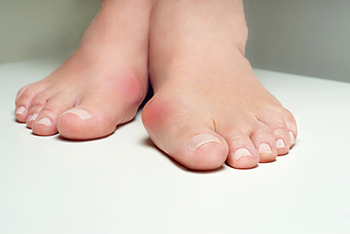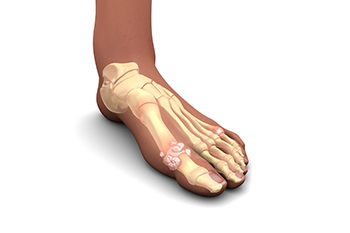Connect With Us
Blog
Items filtered by date: September 2025
Bunions and How to Manage Them

A bunion is a bony bump that forms at the base of the big toe, causing the joint to protrude outward and the toe to angle toward the others. Bunions develop due to pressure on the joint over time, often from wearing tight or poorly fitting shoes, abnormal gait, or foot structure. Genetics play a significant role, as inherited foot shapes, such as flat feet or low arches, can increase susceptibility. Risk factors include high activity levels, wearing narrow footwear, and age. A podiatrist can help by assessing the severity of the bunion, recommending custom orthotics, providing footwear guidance, and discussing treatment options, including conservative care or surgical correction. If you have developed a bunion, it is suggested that you consult a podiatrist who can offer appropriate treatment solutions.
If you are suffering from bunions, contact Lawrence Fallat, DPM of Michigan. Our doctor can provide the care you need to keep you pain-free and on your feet.
What Is a Bunion?
A bunion is formed of swollen tissue or an enlargement of boney growth, usually located at the base joint of the toe that connects to the foot. The swelling occurs due to the bones in the big toe shifting inward, which impacts the other toes of the foot. This causes the area around the base of the big toe to become inflamed and painful.
Why Do Bunions Form?
Genetics – Susceptibility to bunions are often hereditary
Stress on the feet – Poorly fitted and uncomfortable footwear that places stress on feet, such as heels, can worsen existing bunions
How Are Bunions Diagnosed?
Doctors often perform two tests – blood tests and x-rays – when trying to diagnose bunions, especially in the early stages of development. Blood tests help determine if the foot pain is being caused by something else, such as arthritis, while x-rays provide a clear picture of your bone structure to your doctor.
How Are Bunions Treated?
- Refrain from wearing heels or similar shoes that cause discomfort
- Select wider shoes that can provide more comfort and reduce pain
- Anti-inflammatory and pain management drugs
- Orthotics or foot inserts
- Surgery
If you have any questions, please feel free to contact our offices located in Canton and Taylor, MI . We offer the newest diagnostic and treatment technologies for all your foot care needs.
Reasons Gout Surgery May Be Needed

Gout is a painful condition that occurs when uric acid crystals build up in the joints, often affecting the big toe, toes, or ankle. While many people can manage symptoms of gout with conservative care, some cases may require surgery. A podiatrist may recommend gout surgery when painful tophi, or hard deposits of uric acid, develop under the skin of the toes, feet, or ankles and interfere with walking. Surgery may also be needed if gout causes joint damage that limits mobility or if repeated flare-ups lead to lasting deformities in the foot. In some severe cases, untreated gout can increase the risk of limb loss if not properly addressed. A podiatrist can perform surgery to remove deposits, repair damaged joints, or improve alignment to reduce pain and restore function. If you suffer from gout, it is suggested that you make an appointment with a podiatrist for an exam, diagnosis, and help in managing this painful condition.
Gout is a foot condition that requires certain treatment and care. If you are seeking treatment, contact Lawrence Fallat, DPM from Michigan. Our doctor will treat your foot and ankle needs.
What Is Gout?
Gout is a type of arthritis caused by a buildup of uric acid in the bloodstream. It often develops in the foot, especially the big toe area, although it can manifest in other parts of the body as well. Gout can make walking and standing very painful and is especially common in diabetics and the obese.
People typically get gout because of a poor diet. Genetic predisposition is also a factor. The children of parents who have had gout frequently have a chance of developing it themselves.
Gout can easily be identified by redness and inflammation of the big toe and the surrounding areas of the foot. Other symptoms include extreme fatigue, joint pain, and running high fevers. Sometimes corticosteroid drugs can be prescribed to treat gout, but the best way to combat this disease is to get more exercise and eat a better diet.
If you have any questions, please feel free to contact our offices located in Canton and Taylor, MI . We offer the newest diagnostic and treatment technologies for all your foot care needs.
The Importance of Fall Protection at Work

Falls are a leading cause of workplace injuries and can have serious consequences, especially for the feet and ankles. Injuries from falls may include fractures, sprains, and long-term joint problems that affect mobility and quality of life. Preventing falls involves using proper safety equipment, maintaining clean and dry work areas, wearing slip resistant footwear, and following established safety protocols. A podiatrist can evaluate and treat foot and ankle injuries resulting from falls, provide guidance on supportive footwear, and recommend strategies to restore strength and balance. If you have endured a foot or ankle injury from falling, it is suggested that you promptly consult a podiatrist who can provide an accurate diagnosis and treatment.
Preventing falls among the elderly is very important. If you are older and have fallen or fear that you are prone to falling, consult with Lawrence Fallat, DPM from Michigan. Our doctor will assess your condition and provide you with quality advice and care.
Every 11 seconds, an elderly American is being treated in an emergency room for a fall related injury. Falls are the leading cause of head and hip injuries for those 65 and older. Due to decreases in strength, balance, senses, and lack of awareness, elderly persons are very susceptible to falling. Thankfully, there are a number of things older persons can do to prevent falls.
How to Prevent Falls
Some effective methods that older persons can do to prevent falls include:
- Enrolling in strength and balance exercise program to increase balance and strength
- Periodically having your sight and hearing checked
- Discuss any medications you have with a doctor to see if it increases the risk of falling
- Clearing the house of falling hazards and installing devices like grab bars and railings
- Utilizing a walker or cane
- Wearing shoes that provide good support and cushioning
- Talking to family members about falling and increasing awareness
Falling can be a traumatic and embarrassing experience for elderly persons; this can make them less willing to leave the house, and less willing to talk to someone about their fears of falling. Doing such things, however, will increase the likelihood of tripping or losing one’s balance. Knowing the causes of falling and how to prevent them is the best way to mitigate the risk of serious injury.
If you have any questions, please feel free to contact our offices located in Canton and Taylor, MI . We offer the newest diagnostic and treatment technologies for all your foot care needs.
Finding the Right Shoe Size for Healthy Feet

Wearing shoes that fit correctly is essential for comfort and long-term foot health. To measure your foot, place it on a flat surface and use a ruler or measuring tape from the heel to the longest toe, then compare with a shoe size chart. Be sure to measure both feet since one is often slightly larger. Shoes that are too small or too large can cause issues such as blisters, bunions, hammertoes, corns, and even chronic foot pain. A podiatrist can evaluate your foot structure, recommend proper footwear, and address any damage caused by ill-fitting shoes. If you have foot pain from wearing shoes that do not fit correctly, it is suggested that you consult a podiatrist who can treat various foot conditions, and guide you on how to choose shoes that fit properly.
It is important to find shoes that fit you properly in order to avoid a variety of different foot problems. For more information about treatment, contact Lawrence Fallat, DPM from Michigan. Our doctor will treat your foot and ankle needs.
Proper Shoe Fitting
Shoes have many different functions. They cushion our body weight, protect our feet, and allow us to safely play sports. You should always make sure that the shoes you wear fit you properly in order to avoid injuries and deformities such as: bunions, corns, calluses, hammertoes, plantar fasciitis, stress fractures, and more. It is important to note that although a certain pair of shoes might be a great fit for someone else, that doesn’t mean they will be a great fit for you. This is why you should always try on shoes before buying them to make sure they are worth the investment. Typically, shoes need to be replaced ever six months to one year of regular use.
Tips for Proper Shoe Fitting
- Select a shoe that is shaped like your foot
- Don’t buy shoes that fit too tight, expecting them to stretch to fit
- Make sure there is enough space (3/8” to ½”) for your longest toe at the end of each shoe when you are standing up
- Walk in the shoes to make sure they fit and feel right
- Don’t select shoes by the size marked inside the shoe, but by how the shoe fits your foot
The shoes you buy should always feel as good as they look. Shoes that fit properly will last longer, feel better, and improve your way of life each day.
If you have any questions please contact our offices located in Canton and Taylor, MI . We offer the newest diagnostic and treatment technologies for all your foot and ankle needs.
Gout Pain Can Be Managed
Problems Caused by High Arches

High arches, also known as pes cavus, occur when the arch of the foot is raised higher than normal, creating an exaggerated curve from the heel to the toes. Having high arches places uneven pressure on the feet, often concentrating weight on the heel and the ball of the foot. People with high arches may experience pain in the arches, toes, or ankles due to the extra strain on the metatarsals and surrounding structures. Shortened foot length, difficulty fitting into shoes, and instability during walking or running are also common problems. The excess pressure can lead to calluses, ankle sprains, hammertoes, or even stress fractures. A podiatrist can evaluate the structure and flexibility of the foot, order imaging if needed, and recommend proper support or surgery in severe cases. If you have arch pain, it is suggested that you make an appointment with a podiatrist for an evaluation and treatment.
If you have any concerns about your feet, contact Lawrence Fallat, DPM from Michigan. Our doctor can provide the care you need to keep you pain-free and on your feet.
Biomechanics in Podiatry
Podiatric biomechanics is a particular sector of specialty podiatry with licensed practitioners who are trained to diagnose and treat conditions affecting the foot, ankle and lower leg. Biomechanics deals with the forces that act against the body, causing an interference with the biological structures. It focuses on the movement of the ankle, the foot and the forces that interact with them.
A History of Biomechanics
- Biomechanics dates back to the BC era in Egypt where evidence of professional foot care has been recorded.
- In 1974, biomechanics gained a higher profile from the studies of Merton Root, who claimed that by changing or controlling the forces between the ankle and the foot, corrections or conditions could be implemented to gain strength and coordination in the area.
Modern technological improvements are based on past theories and therapeutic processes that provide a better understanding of podiatric concepts for biomechanics. Computers can provide accurate information about the forces and patterns of the feet and lower legs.
Understanding biomechanics of the feet can help improve and eliminate pain, stopping further stress to the foot.
If you have any questions please feel free to contact our offices located in Canton and Taylor, MI . We offer the newest diagnostic and treatment technologies for all your foot and ankle needs.

